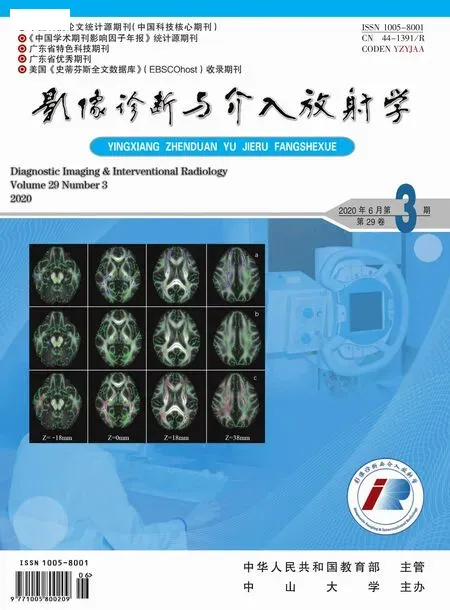Glomus Tympanicum 鼓室球瘤
Key Facts
Synonym:Glomus tympanicum paraganglioma (GTP).Definition:Benign tumor that arises in glomus bodies situated on cochlear promontory of medial wall of middle ear cavity.
Classic imaging appearance:Round mass with base on cochlear promontory;CT shows no bone erosion and enhanced MR shows intense enhancement.GTP may be clinically indistinguishable from glomus jugulotympanicum paraganglioma or aberrant internal carotid artery.It is the most common tumor of middle ear cavity.
医学词汇注释与简要讲解
glomus tympanicum 鼓室球瘤
paraganglioma 副神经节瘤
cochlear 耳蜗
promontory 岬,隆起
glomus jugulotympanicum paraganglioma 颈鼓室副节瘤
Imaging Findings
Best imaging clue:(1)MR shows enhancing mass on cochlear promontory;(2)Floor of middle ear cavity is intact (if eroded,jugulotympanicum).
CT findings:(1)Focal mass on cochlear promontory is characteristic;(2)Small lesions:Fills lower middle ear,just reaches medial border of tempanic membrane(TM);(3)Large lesions:Fills middle ear cavity,creating attic block resulting in fluid collection in mastoid;margins of tumor not visible on CT;(4)Bone erosion not usually present with GTP,even with larger lesions;(5)Rare involvement of air cells along the inferior cochlear promontory may be mistaken for invasion.
MR findings:(1)Enhanced T1WI shows focal enhancing mass on cochlear promontory;(2)Small GTP will be missed if slice thickness exceeds 3 mm;(3)Very large GTP may leave middle ear via eustachian tube.
Angiography findings:(1)Unnecessary if GTP diagnosis clearly established by CT;(2)GTP supplied by enlarged ascending pharyngeal artery and its inferior tympanic branch,via inferior tympanic canaliculus
Imaging Recommendations:(1)Bone-only CT without contrast best if GTP suspected clinically;(2)MR and angiography only used if glomus jugulotympanicum found by CT.
tempanic membrane 鼓膜
mastoid 乳突
eustachian tube 耳咽管
ascending pharyngeal artery 咽升动脉
tympanic canaliculus 鼓室管
Differential Diagnosis:Middle Ear Mass
Aberrant internal carotid artery:(1)Tubular mass crosses middle ear cavity to rejoin horizontal petrous ICA;large inferior tympanic canaliculus;(2)Vascular mass behind TM and/or pulsatile tinnitus.
pulsatile tinnitus 搏动性耳鸣
dehiscent jugular bulb 颈静脉球分裂
Dehiscent jugular bulb:(1)CT shows sigmoid plate is dehiscent;venous protrusion into middle ear cavity from superolateral jugular bulb;(2)Asymptomatic incidental otoscopic observation.
Congenital cholesteatoma of middle ear:(1)Enhanced T1WI shows no enhancement;(2)Clinical:“White” mass behind intact TM.
Glomus jugulotympanicum paraganglioma:(1)CT shows permeative change in bony floor of middle ear;(2)Identical to GTP.
otoscopic observation 内耳镜检
cholesteatoma 胆脂瘤
Pathology
Etiology-Pathogenesis:Arise from glomus (L."a ball") bodies (paraganglia)found along inferior tympanic nerve(Jacobson’s nerve)on cochlear promontory.Chemoreceptor cells derived from primitive neural crest.Nonchromaffin(nonsecretory) in this location.
Epidemiology:(1)GTP=most common tumor of middle ear;(2)GTP not associated with multicentric paragangliomas.
Gross pathologic or surgical features:Glistening,red polypoid mass with base on cochlear promontory;fibrous pseudocapsule.
Microscopic features:(1)Biphasic cell pattern composed of chief cells and sustentacular cells surrounded by fibromuscular stroma;(2)Chief cells arranged in characteristic compact cell nests or balls of cells;(3)Immunohistochemistry:chief cells show a diffuse reaction to chromogranin;(4)Electronmicroscopy shows neurosecretory granules.
nonchromaffin 非嗜铬的
[suffix]-oid 样的,状态
polypoid 息肉状的
sarcomatoid 肉瘤样的
sustentacular cells 支持细胞
chromogranin 嗜铬粒蛋白
Glasscock-Jackson Classification of GTP:
Type Ⅰ:Small mass limited to cochlear promontory;
Type Ⅱ:Tumor completely filling middle ear space;
Type Ⅲ:Tumor filling middle ear and extending into mastoid air cells;
Type Ⅳ:Tumor flling middle ear,extending into the mastoid or through tympanic membrane to fill the external auditory canal;may extend anterior to carotid artery.
Clinical Issues
Presentation:(1)Principal presenting sign:vascular retrotympanic mass;(2)Other symptoms:pulsatile tinnitus (90%),conductive hearing loss (50%),facial nerve paralysis (5%) and asymptomatic (5%);(3)Three times more common in women than men;(4)66% are between 40-60 years of age at diagnosis;(5)Vascular (red) retrotympanic mass (anteroinferior quadrant of tympanic membrane).
vascular retrotympanic mass 鼓膜后血管性肿物(蓝鼓膜)
conductive hearing loss 传导性听力下降
facial nerve paralysis 面神经麻痹
Natural History
Slow-growing,non-invasive tumor.
Average time from onset of symptoms to surgical treatment is 3 years.
Treatment
Tympanotomy for smaller lesions;mastoidectomy for larger lesions.Incomplete surgery of glomus jugulotympanicum paraganglioma or biopsy of an aberrant internal carotid artery may result in serious patient complications.The radiologist must correctly interpret the pretreatment images.
tympanotomy 鼓膜切开术
mastoidectomy 乳突切除术
Prognosis
Complete resection yields a permanent surgical cure.

